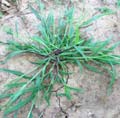- Like all weeds, the number one crabgrass prevention is maintaining a healthy lawn. Make sure that your beautiful grass is thick enough to cover your yard. Without sunlight reaching the soil, crabgrass can’t take root.
- Don’t mow your grass too low as crabgrass will take advantage of the increased sunlight at dirt-level. Two and a half to three inches should be about right.
- Try to remove crabgrass as soon as you see it. Crabgrass is so fertile that an innocuous appearance can quickly turn into a full-blown grass patch.
- Mulch the soil after removing crabgrass. This helps ensure that whatever roots remain don’t take seed and ruin your lawn grass later.
- Heavily water the area you are weeding before removing the crabgrass. The dampness will loosen up the dirt and make removal easier.
- Make sure you get the entire root. Crabgrass is a tenacious weed. In the right conditions, its roots will grow wherever they touch soil.
- Only use chemicals as a last resort. A herbicide that only kills crabgrass doesn’t exist, so other plants will always be vulnerable to chemical treatment.
- Pre-emergent chemicals do exist, but it is hard to decide when is best to apply these preventive chemicals. If you apply them too early, their effects will fade, and the crabgrass might take hold later. If you apply the chemicals too late, the crabgrass may already be there.
- Always use gloves to protect your hands when gardening, especially when using chemicals,
 Be reasonable. Crabgrass is difficult to ever completely root out, but you can get most of it and enjoy a beautiful grass lawn
Be reasonable. Crabgrass is difficult to ever completely root out, but you can get most of it and enjoy a beautiful grass lawn
Technorati Tags: crabgrass, gardening
 Be reasonable. Crabgrass is difficult to ever completely root out, but you can get most of it and enjoy a beautiful grass lawn
Be reasonable. Crabgrass is difficult to ever completely root out, but you can get most of it and enjoy a beautiful grass lawn